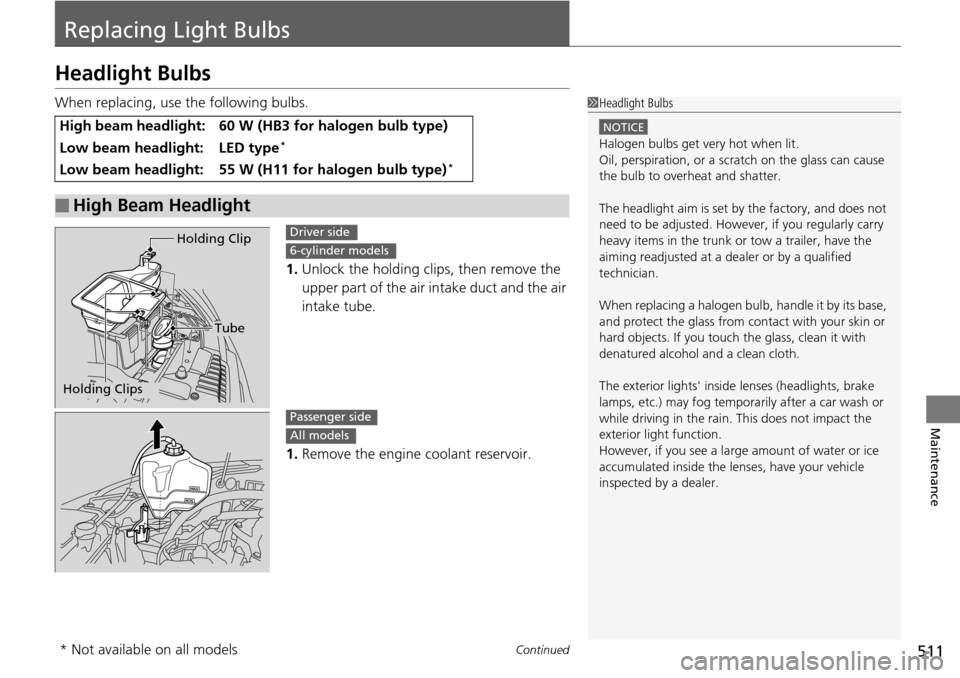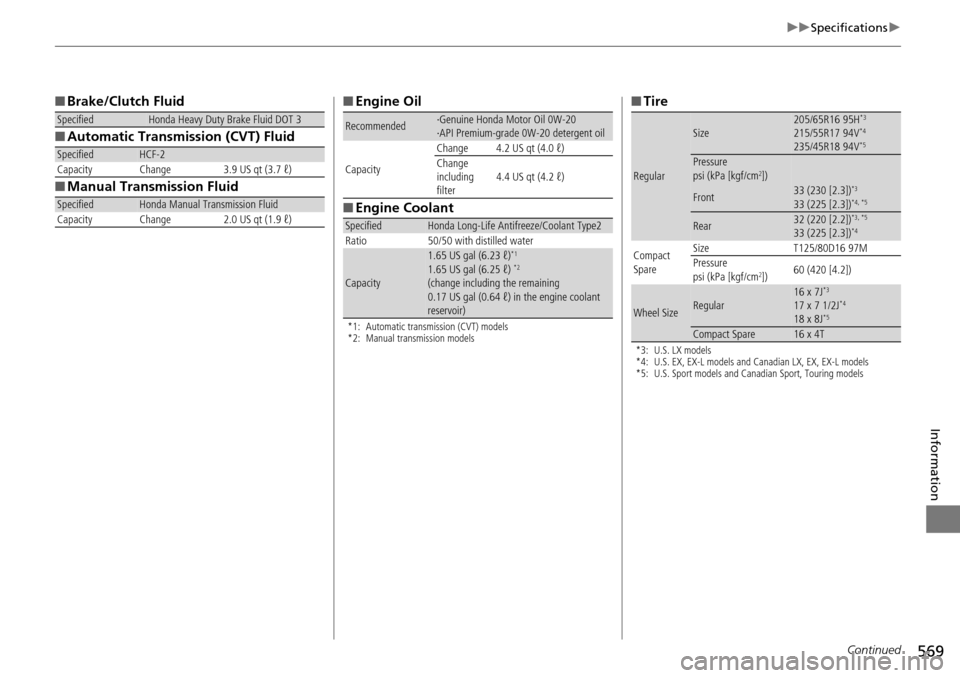Page 496 of 593
495Continued
Maintenance
Maintenance Under the Hood
Maintenance Items Under the Hood
4-cylinder models
Brake Fluid
(Black Cap)
Engine Coolant
Reservoir Radiator Cap
Washer Fluid
(Blue Cap) Engine Oil Dipstick
(Orange Handle)
Clutch Fluid
(Light Gray Cap)
Engine Oil Fill Cap
Battery
Manual transmission
models
Page 497 of 593
496
uuMaintenance Under the Hood uMaintenance Items Under the Hood
Maintenance
6-cylinder models
Engine Oil Dipstick
(Orange Handle)
Washer Fluid
(Blue Cap)
Engine Coolant
Reservoir
Radiator Cap Brake Fluid
(Black Cap)
Engine Oil Fill Cap
Battery
Page 506 of 593

505
uuMaintenance Under the Hood uEngine Coolant
Continued
Maintenance
Engine Coolant
This coolant is premixed with 50% an tifreeze and 50% water. Do not add any
straight antifreeze or water.
We recommend you check the engine coolant level every time you refuel. Check the
engine coolant reservoir first. If it is co mpletely empty, also check the coolant level
in the radiator. Add the e ngine coolant accordingly.
1.Check the amount of coolant in the engine
coolant reservoir.
2. If the coolant level is below the MIN mark,
add the specified coolant until it reaches
the MAX mark.
3. Inspect the cooling system for leaks.
Specified coolant: Ho nda Long Life Antifreeze/Coolant Type 2
■Engine Coolant Reservoir
1Engine Coolant
NOTICE
If temperatures c onsistently below −22°F (−30°C) are
expected, the coolant mixture should be changed to
a higher concentration. Cons ult a dealer for more
information.
If Honda antifreeze /coolant is not available, you may
use another major brand non- silicate coolant as a
temporary replacement. Check that it is a high quality
coolant recommended for aluminum engines.
Continued use of any non-Honda coolant can result
in corrosion, causing the cooling system to
malfunction or fail. Have the cooling system flushed
and refilled with Honda antifreeze/coolant as soon as
possible.
Do not add rust inhibitors or other additives to your
vehicle's coolant system. They may not be compatible
with the coolant or with the engine components.
Engine
Coolant
Reservoir
MAX
MIN
Page 507 of 593
uuMaintenance Under the Hood uEngine Coolant
506
Maintenance
1. Make sure the engine and radiator are
cool.
2. Turn the radiator cap counterclockwise and
relieve any pressure in the coolant system.
Do not push the cap down when turning.
3. Push down and turn the radiator cap
counterclockwise to remove it.
4. The coolant level should be up to the base
of the filler neck. Add coolant if it is low.
5. Put the radiator cap back on, and tighten it
fully.
6. Pour coolant into the engine coolant
reservoir until it reaches the MAX mark. Put
the cap back on the engine coolant
reservoir.
■Radiator1 Radiator
NOTICE
Pour the fluid slowly and ca refully so you do not spill
any. Clean up any spills immediately; they can
damage components in the engine compartment.
3WARNING
Removing the radiator cap while the
engine is hot can cause the coolant to spray
out, seriously scalding you.
Always let the engine and radiator cool
down before removing the radiator cap.
Radiator Cap
Page 512 of 593

511Continued
Maintenance
Replacing Light Bulbs
Headlight Bulbs
When replacing, use the following bulbs.1.Unlock the holding clips, then remove the
upper part of the air intake duct and the air
intake tube.
1. Remove the engine coolant reservoir.
High beam headlight: 60 W (HB3 for halogen bulb type)
Low beam headlight: LED type*
Low beam headlight: 55 W (H11 for halogen bulb type)*
■High Beam Headlight
1Headlight Bulbs
NOTICE
Halogen bulbs get very hot when lit.
Oil, perspiration, or a scratch on the glass can cause
the bulb to overhe at and shatter.
The headlight aim is set by the factory, and does not
need to be adjusted. Howeve r, if you regularly carry
heavy items in the trunk or tow a trailer, have the
aiming readjusted at a de aler or by a qualified
technician.
When replacing a halogen bu lb, handle it by its base,
and protect the glass from c ontact with your skin or
hard objects. If you touch the glass, clean it with
denatured alcohol and a clean cloth.
The exterior lights' inside lenses (headlights, brake
lamps, etc.) may fog temporarily after a car wash or
while driving in the rain. This does not impact the
exterior light function.
However, if you see a larg e amount of water or ice
accumulated inside the le nses, have your vehicle
inspected by a dealer.
Tube
Holding Clip
Holding Clips
Driver side
6-cylinder models
Passenger side
All models
* Not available on all models
Page 558 of 593

557
uuOverheating uHow to Handle Overheating
Handling the Unexpected
■Next thing to do
1.Check that the cooling fan is operating and
stop the engine once the temperature
gauge needle comes down.
u If the cooling fan is not operating,
immediately stop the engine.
2. Once the engine has cooled down, inspect
the coolant level and check the cooling
system components for leaks.
u If the coolant level in the engine coolant
reservoir is low, add coolant until it
reaches the MAX mark.
u If there is no coolant in the engine
coolant reservoir, chec k that the radiator
is cool. Cover the radiator cap with a
heavy cloth and open the cap. If
necessary, add coolant up to the base of
the filler neck, and put the cap back on.
■Last thing to do
Once the engine has cooled sufficiently, restart it and check the temperature gauge.
If the temperature gauge needle has gone dow n, resume driving. If it has not gone
down, contact a dealer for repairs.
1 How to Handle Overheating
If the coolant is leaking, contact a dealer for repairs.
Use water as an emergency/temporary measure only.
Have a dealer flush the system with proper antifreeze
as soon as possible.
3WARNING
Removing the radiator cap while the
engine is hot can cause the coolant to spray
out, seriously scalding you.
Always let the engine and radiator cool
down before removing the radiator cap.
MAX
Engine Coolant Reservoir
MIN
Page 570 of 593

569
uuSpecifications u
Continued
Information
■Brake/Clutch Fluid
■ Automatic Transmission (CVT) Fluid
■ Manual Transmission Fluid
SpecifiedHonda Heavy Duty Brake Fluid DOT 3
SpecifiedHCF-2
Capacity Change 3.9 US qt (3.7 ℓ)
SpecifiedHonda Manual Transmission Fluid
Capacity Change 2.0 US qt (1.9 ℓ)
■ Engine Oil
■ Engine Coolant
*1: Automatic transmission (CVT) models
*2: Manual transmission models
Recommended·Genuine Honda Motor Oil 0W-20
·API Premium-grade 0W-20 detergent oil
Capacity Change 4.2 US qt (4.0 ℓ)
Change
including
filter
4.4 US qt (4.2 ℓ)
SpecifiedHonda Long-Life Antifreeze/Coolant Type2
Ratio 50/50 with distilled water
Capacity
1.65 US gal (6.23 ℓ)*1
1.65 US gal (6.25 ℓ) *2
(change including the remaining
0.17 US gal (0.64 ℓ) in the engine coolant
reservoir)
■ Tire
*3: U.S. LX models
*4: U.S. EX, EX-L models and Canadian LX, EX, EX-L models
*5: U.S. Sport models and Canadian Sport, Touring models
Regular
Size205/65R16 95H*3
215/55R17 94V*4
235/45R18 94V*5
Pressure
psi (kPa [kgf/cm2])
Front33 (230 [2.3])*3
33 (225 [2.3])*4, *5
Rear32 (220 [2.2])*3, *5
33 (225 [2.3])*4
Compact
Spare Size
T125/80D16 97M
Pressure
psi (kPa [kgf/cm
2]) 60 (420 [4.2])
Wheel SizeRegular16 x 7J*3
17 x 7 1/2J*4
18 x 8J*5
Compact Spare16 x 4T
Page 572 of 593
571
uuSpecifications u
Information
■Brake Fluid
■ Automatic Transmission Fluid
SpecifiedHonda Heavy Duty Brake Fluid DOT 3
SpecifiedHonda ATF DW-1
(automatic transmission fluid)
Capacity Change 3.3 US qt (3.1 ℓ)
■ Engine Oil
■ Engine Coolant
Recommended·Genuine Honda Motor Oil 0W-20
·API Premium-grade 0W-20 detergent oil
Capacity Change 4.2 US qt (4.0 ℓ)
Change
including
filter
4.5 US qt (4.3 ℓ)
SpecifiedHonda Long-Life Antifreeze/Coolant Type2
Ratio 50/50 with distilled water
Capacity
1.7 US gal (6.5 ℓ)
(change including the remaining
0.17 US gal (0.64 ℓ) in the engine coolant
reservoir)
■ Tire
*1: U.S. models and Canadian EX-L V6 models
*2: Canadian V6 Touring models
Regular
Size215/55R17 94V*1
235/45R18 94V*2
Pressure
psi (kPa [kgf/cm2])33 (225 [2.3])Front
Rear33 (225 [2.3])*1
32 (220 [2.2])*2
Compact
Spare Size
T125/80D16 97M
Pressure
psi (kPa [kgf/cm
2]) 60 (420 [4.2])
Wheel SizeRegular17 x 7 1/2J*1
18 x 8J*2
Compact Spare16 x 4T